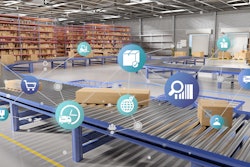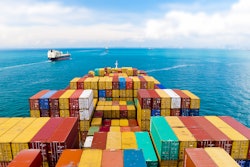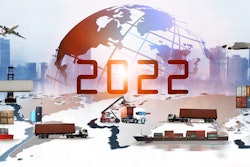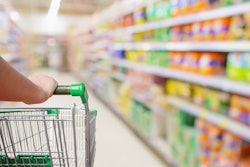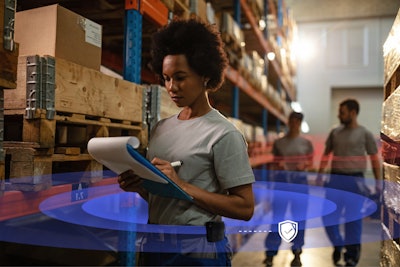
When 2021 hit, the world was ready for the New Year. Even if it brought with it a New Normal -- new way of doing business, a new way to shop for groceries and more -- the turning of the calendar meant putting a year of supply chain disruptions, restaurant closures and constant pivoting behind us.
But, then, on March 23, a stranded Evergreen container ship blocked navigation in Egypt’s Suez Canal, setting the stage for what would be a slew of supply chain disruptions after supply chain disruptions.
Suddenly, 2021 was quickly becoming a mirrored reflection of the year prior.
Then came the ransomware attacks, internet outages, container ships stuck at bay, bridge closures, driver shortages, ingredient shortages, natural disasters and more.
The hits just kept on hitting.
And, industry experts are already showing signs of struggle for 2022 into 2023, as routes to import/export remain clogged, ports continue to be backed up, cost of doing business increases and the labor shortage exists.
That’s because supply chains are messy. And, they’re only going to get worse before they get better.
In Food Logistics’ Nov/Dec 2021 issue, editor-in-chief Marina Mayer talks with several industry experts about the state of the supply chain and what’s in store for 2022.
Here’s an interview with Dustin Burke, managing director and partner, global co-leader of BCG’s manufacturing and supply chain topic, Boston Consulting Group, to detail the importance of real-time visibility solutions, with excerpts publishing in Food Logistics’ Nov/Dec 2021 issue. [CLICK HERE to read the article in full].
Food Logistics: 2021 started off with supply chain disruption after supply chain disruption. From the Suez Canal blockage and natural disasters to ransomware attacks and an industry-wide labor shortage, the supply chain industry is having to prove its resiliency over and over again. Looking into 2022, what does the state of the supply chain look like?
Dustin Burke: First, it’s important to note that the supply chain is about more than just logistics. The supply chain starts with the availability of raw materials and ends with the availability of workers to stock store shelves, consisting of everything else in between. The good news is that food is not impacted by a lack of raw materials the way that other industries are, such as those facing a lack of semiconductors (with a few notable exceptions, including aluminum can shortages). The greatest challenges in the food supply chain result from food being disproportionately dependent on transportation and labor. Much of the price of food for consumers comes from rail and trucking costs, as well as manufacturing and distribution.
Freight volume continues to overwhelm capacity across much of our transportation network – a problem [that] will be difficult to address until well into 2022, when retail spending softens a bit. The supply chain is also facing labor shortages, including a lack of skilled technicians to fix warehouse equipment, an exodus of distribution center employees after being poached by e-commerce players and increasing turnover of in-store retail associates. These pinch points will continue to impact product service levels – and therefore products on the shelf – well into next year.
Food Logistics: The cold food chain continues to face a host of risk/security challenges. What can companies be doing now to adapt for the future?
Burke: The cold chain is more complex than the ambient chain, as it is more expensive to operate, takes a larger capital investment, requires specific expertise and is almost always more capacity constrained. If you go into any food distributor’s multi-zone distribution center, it seems to be that that the colder the zone, the fuller it is. This above-average profitability means the cold chain is attracting investments and adding more capacity.
Companies can of course make their own investments, but they should also find ways to be more flexible. For example, companies should ensure they can adjust zones in distribution centers and trucks. We know capacity is an issue for the cold chain, so companies should identify ways to move goods faster, for optimal speed and efficiency so that a greater amount of product can flow through that limited capacity. Because the cold chain puts a premium on precise delivery time, companies should consider synchronizing those with outbound shipments. Overall, cold chain companies need to optimize their planning capabilities, which means they will need to upgrade their technology and how they use it.
Food Logistics: In terms of transportation, what are some of the trends you’re seeing for 2022? How do emerging technologies like blockchain, Internet of Things, cloud-based, etc. play a role in the evolution of transportation in the cold food chain?
Burke: These emerging technology and transportation trends have already existed for a couple years, but some will accelerate. Knowing which trends will become key players comes down to business needs. Many companies had a painful experience with their supply chains in 2020-2021 and will continue to bolster their supply chains to be more resilient, without adding too much cost, relying on technologies such as real-time visibility, predictive analytics and data-sharing platforms.
Another trend to consider is the pace of carbon reduction commitments. If your customer has made a carbon reduction pledge or commitment, you will be expected to help them reduce their carbon footprint. It will soon become the norm for those in the food supply chain to quantify carbon usage and articulate plans to reduce it. This may be a particular challenge for the cold chain as they will need to consider the requirements and guidelines from all the companies they partner with.
Food Logistics: Let’s talk supply chain visibility. What is your company – or what should companies – be doing to improve their own supply chain visibility?
Burke: Companies should focus on utilizing real-time visibility solutions. While they are ubiquitous now, companies may not be utilizing them to reach their full impact. Many companies are using real-time visibility solutions for creating visuals or tracking shipments on an ad-hoc basis. While this is useful, this technology can do so much more. All the information from real-time visibility solutions needs to be integrated into specific business activities, such as labor planning and customer service. This information needs to be automatically shared with the appropriate parties and combined with other data, so operators and planners can make informed decisions. For example, production planners should automatically have information about the arrival time of key raw material deliveries as they set production schedules for the following week.
Food Logistics: The labor shortage is a real thing, and it’s impacting several facets of the supply chain. What is your company – or what should companies – be doing to hire, onboard and retain good quality supply chain workers?
Burke: Unfortunately, there’s no easy answer or quick solution to the labor shortage problem in the supply chain. The most impactful thing companies can do in the short term is to work harder to keep the people they already have. This does not mean “lowering the bar” by any means. Most workers want to be engaged during their workday, develop their skills, and have flexibility. Companies should focus on equipping managerial talent with what they need to be great coaches for their direct reports, examining their employee value proposition, supporting high performers, and giving them more responsibility while also providing employees the right amount of flexibility.
Food Logistics: What are some things not addressed above that may be pertinent to our readers?
Burke: It will be very interesting to see how the changing nature of work impacts our food industry. While many people are physically back at work, not all are. For many people, more days will be spent working from home, either by choice or company policy. People’s eating habits and preferences may differ depending on whether they are home or at work. Food companies have an interesting opportunity to appeal to that, and to cater toward those differences. Whatever types of products win this new working dynamic will, of course, have to be supplied. So that will have supply chain implications for raw materials, manufacturing capacity and packaging types.
[CLICK HERE to read the article in full].





